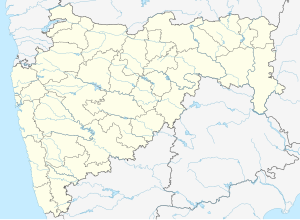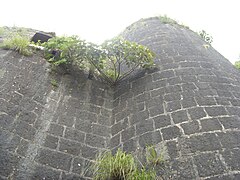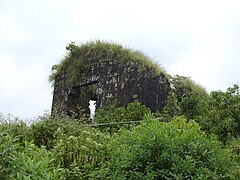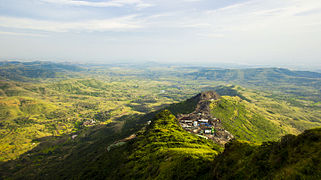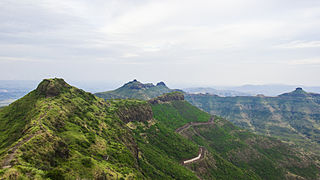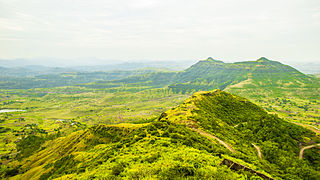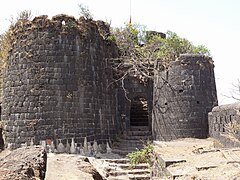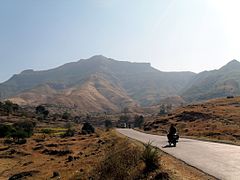Purandar Fort: Difference between revisions
imported>Tanmayaw14 No edit summary |
No edit summary |
||
| Line 1: | Line 1: | ||
{{Short description|Fort in Maharashtra, India}} | |||
{{Use dmy dates|date=January 2015}} | {{Use dmy dates|date=January 2015}} | ||
{{Use Indian English|date=January 2015}} | {{Use Indian English|date=January 2015}} | ||
{{Infobox military installation | {{Infobox military installation | ||
|image=Purandar_Fort_-_AB.jpg | |||
|name = Purandar Fort | |name = Purandar Fort | ||
|native_name | |native_name = | ||
|partof = | |partof = | ||
|location = [[Pune district]], [[Maharashtra]] | |location = [[Pune district]], [[Maharashtra]] | ||
|caption = Purandhar Fort | |caption = Purandhar Fort | ||
|map_type=India#India Maharashtra | |map_type=India#India Maharashtra | ||
|map_size = 300 | |map_size = 300 | ||
| Line 20: | Line 22: | ||
}} | }} | ||
'''Purandar Fort''' is | '''Purandar Fort''' is a mountain fort in [[Pune district]] in [[Western India]]n state of [[Maharashtra]], India. The fort stands at 4,472 ft (1,390 m) above the sea level in the [[Western Ghats]], 50 km to the southeast of [[Pune]]. | ||
The twin forts of Purandar and Vajragad (or Rudramal) of which the latter is the smaller of the two, is located on the eastern side of the main fort. The village of [[Purandar taluka|Purandar]] takes its name from this fort.<ref> | The twin forts of Purandar and Vajragad (or Rudramal) of which the latter is the smaller of the two, is located on the eastern side of the main fort. The village of [[Purandar taluka|Purandar]] takes its name from this fort.<ref>[https://www.hindustantimes.com/pune-news/this-monsoon-visit-the-mystical-purandar-fort-near-pune/story-C8TJVMjOWBn16HziHCRTeN.html This monsoon visit Purandar fort]</ref> It is the birthplace of Dharmaveer Chatrapati Sambhaji Maharaj.<ref name = express>[http://www.maharashtratourism.gov.in/MTDC/HTML/MaharashtraTourism/Default.aspx?strpage=../MaharashtraTourism/TouristDelight/Forts/PurandarFort.html Maharashtra state tourism site]</ref> | ||
== History == | == History == | ||
The oldest known reference to the Purandar dates back to the [[Yadava dynasty]] in the 11th century.{{cn|date=March 2022}} | |||
After the defeat of the Yadavas by the [[Persians|Persian]] invaders,{{cn|date=March 2022}} the territory surrounding the fort fell into the hands of the Persians who further fortified the Purandar Fort in 1350 A.D. During the early rule of the [[Ahmadnagar Sultanate|Bijapur]] and [[Ahmadnagar Sultanate|Ahmednagar]] kings, The Purandar Fort was among the forts directly under the Government rule and was never entrusted to [[Jagirdar]]s.<ref name=gazette>{{Citation | last=Hunter| first=William| title=The Imperial Gazetteer of India| publisher=Trubner and Co.| place=London| year=1886| url = https://archive.org/stream/imperialgazettee11hunt/imperialgazettee11hunt_djvu.txt| access-date = 2009-01-18}}</ref> | |||
After the defeat of the Yadavas by the [[Persians|Persian]] invaders, the territory surrounding the fort fell into the hands of the Persians who further fortified the Purandar Fort in 1350 A.D. During the early rule of the [[Ahmadnagar Sultanate|Bijapur]] and [[Ahmadnagar Sultanate|Ahmednagar]] kings, The Purandar Fort was among the forts directly under the Government rule and was never entrusted to [[Jagirdar]]s | |||
Under the rule of the [[Berar Sultanate]], the fort was besieged several times. To prevent the Purandar Fort from ever falling again, a sacrificial ritual was performed where a man and a woman were buried alive under one of the fort bastions to appease its patron deity.<ref>[http://www.maharashtra.gov.in/pdf/gazeetter_reprint/Solapur/appendix_c.html#1 ''Sholapur District Gazetteer'']</ref> Another ritual was soon performed where the king ordered a minister to bury a first-born son and his mother into the foundation of the bastion which was promptly done with a further offering of gold and bricks. When the bastion was finished, The minister, Yesaji Naik, was given possession of the Purandar Fort and the father of the sacrificed boy was rewarded with two villages.<ref name="Toy, 1965">{{cite book|last=Toy|first=Sidney|title=The Fortified Cities of India|url=https://archive.org/details/fortifiedcitieso0000toys|url-access=registration|year=1965|publisher=Heinemann Educational Books Ltd.|location=London|page=[https://archive.org/details/fortifiedcitieso0000toys/page/51 51]}}</ref> | Under the rule of the [[Berar Sultanate]], the fort was besieged several times. To prevent the Purandar Fort from ever falling again, a sacrificial ritual was performed where a man and a woman were buried alive under one of the fort bastions to appease its patron deity.<ref>[http://www.maharashtra.gov.in/pdf/gazeetter_reprint/Solapur/appendix_c.html#1 ''Sholapur District Gazetteer'']</ref> Another ritual was soon performed where the king ordered a minister to bury a first-born son and his mother into the foundation of the bastion which was promptly done with a further offering of gold and bricks. When the bastion was finished, The minister, Yesaji Naik, was given possession of the Purandar Fort and the father of the sacrificed boy was rewarded with two villages.<ref name="Toy, 1965">{{cite book|last=Toy|first=Sidney|title=The Fortified Cities of India|url=https://archive.org/details/fortifiedcitieso0000toys|url-access=registration|year=1965|publisher=Heinemann Educational Books Ltd.|location=London|page=[https://archive.org/details/fortifiedcitieso0000toys/page/51 51]}}</ref> | ||
In 1596 A.D, the ''Bahudar Shah'' of the [[Ahmadnagar Sultanate]] granted the territory of "Pune" and "Supa" to [[Maloji | In 1596 A.D, the ''Bahudar Shah'' of the [[Ahmadnagar Sultanate]] granted the territory of "Pune" and "Supa" to [[Maloji Bhosale]], the grandfather of Shivaji.{{cn|date=May 2021}} The Purandar Fort was included in the territory. | ||
[[File:Vajragad fort.jpg|thumb|left|Vajragad Fort]] | [[File:Vajragad fort.jpg|thumb|left|Vajragad Fort]] | ||
In 1670 A.D, the truce did not last long as | In 1646 A.D, Shivaji, still in his youth, in one of his first victories for the [[Maratha Empire]], raided and established control of the fort. In 1665 A.D, the Purandar Fort was besieged by the forces of [[Aurangzeb]], under the command of [[Jai Singh II]] and assisted by [[Diler Khan]]. [[Murarbaji Deshpande]] of Mahr, who was appointed as the ''killedar'' (keeper of the fort), offered strong resistance against the Mughal forces ultimately giving up his life in a struggle to retain the fort. Shivaji, daunted at the prospect of the fall of his grandfather's fort, signed a treaty known as the [[Treaty of Purandar (1665)|First Treaty of Purandar]] with [[Aurangzeb]] in 1665. According to the treaty, Shivaji handed over twenty-three forts including Purandar, and a territory with a revenue of four lakh ''[[Shivrai|hons]] and was made the ''[[jagirdar]]'' of the territory. | ||
In 1670 A.D, the truce did not last long as Shivaji revolted against Aurangzeb and recaptured Purandar after just five years. | |||
Under the [[Peshwa]] rule, the Purandar Fort acted as a stronghold whenever their capital city of [[Pune]] was under attack. In 1776 A.D, a treaty was signed between the [[British Raj]] and the [[Maratha Empire|Maratha States]] known as the [[Treaty of Purandar (1665)|Second Treaty of Purandar]]. Its conditions were never fulfilled, being overruled by the subsequent [[Treaty of Salbai]] in 1782 between the [[East India Company|Bombay Government]] and [[Raghunathrao]], at the close of the [[First Anglo-Maratha War]].<ref name=gazette/> | Under the [[Peshwa]] rule, the Purandar Fort acted as a stronghold whenever their capital city of [[Pune]] was under attack. In 1776 A.D, a treaty was signed between the [[British Raj]] and the [[Maratha Empire|Maratha States]] known as the [[Treaty of Purandar (1665)|Second Treaty of Purandar]]. Its conditions were never fulfilled, being overruled by the subsequent [[Treaty of Salbai]] in 1782 between the [[East India Company|Bombay Government]] and [[Raghunathrao]], at the close of the [[First Anglo-Maratha War]].<ref name=gazette/> | ||
| Line 62: | Line 63: | ||
[[File:Purandar fort 86.JPG|thumb|Statue of Murarbaji Deshpande]] | [[File:Purandar fort 86.JPG|thumb|Statue of Murarbaji Deshpande]] | ||
From the lower level of the ''machi'', a staircase leads to the upper level called ''Ballekilla''. The first structure of the ''Ballekilla'' that comes into view is the ''Dilli Darwaja'' (Delhi Gate). This area also houses an ancient Kedareshwar ([[Shiva]]) temple. The | From the lower level of the ''machi'', a staircase leads to the upper level called ''Ballekilla''. The first structure of the ''Ballekilla'' that comes into view is the ''Dilli Darwaja'' (Delhi Gate). This area also houses an ancient Kedareshwar ([[Shiva]]) temple. The ''BALLEKILLA'' is also surrounded by steep drop on three sides. | ||
== Current use == | == Current use == | ||
The Purandar Fort is a popular tourist destination and is also used by the [[National Cadet Corps (India)|National Cadet Corps]] academy for training purposes. The fort is a hotspot for [[paraglider]]s and [[backpacking (wilderness)|trekkers]].<ref name=express/> | The Purandar Fort is a popular tourist destination and is also used by the [[National Cadet Corps (India)|National Cadet Corps]] academy for training purposes. The fort is a hotspot for [[paraglider]]s and [[backpacking (wilderness)|trekkers]].<ref name=express/>{{Additional citation needed|date=November 2021}} | ||
==Gallery of Purandar Fort == | ==Gallery of Purandar Fort == | ||
| Line 86: | Line 87: | ||
== See also == | == See also == | ||
* [[List of forts in Maharashtra]] | * [[List of forts in Maharashtra]] | ||
== References == | == References == | ||
{{reflist | {{reflist}} | ||
==External links== | |||
{{commons category|Purandar Fort}} | {{commons category|Purandar Fort}} | ||
{{Pune district topics}} | |||
{{Forts in Maharashtra}} | {{Forts in Maharashtra}} | ||
{{MarathaEmpire}} | |||
{{coord|18|17|N|73|59|E|source:kolossus-cawiki|display=title}} | {{coord|18|17|N|73|59|E|source:kolossus-cawiki|display=title}} | ||
Latest revision as of 12:49, 9 August 2022
| Purandar Fort | |
|---|---|
| Pune district, Maharashtra | |
 Purandhar Fort | |
| Coordinates | 18°16′50.8″N 73°58′25″E / 18.280778°N 73.97361°E |
| Type | Hill fort |
| Height | 1390 mt. |
| Site information | |
| Owner | Government of India |
| Open to the public | Yes |
| Condition | Ruins |
| Site history | |
| Materials | Stone |
Purandar Fort is a mountain fort in Pune district in Western Indian state of Maharashtra, India. The fort stands at 4,472 ft (1,390 m) above the sea level in the Western Ghats, 50 km to the southeast of Pune.
The twin forts of Purandar and Vajragad (or Rudramal) of which the latter is the smaller of the two, is located on the eastern side of the main fort. The village of Purandar takes its name from this fort.[1] It is the birthplace of Dharmaveer Chatrapati Sambhaji Maharaj.[2]
History[edit]
The oldest known reference to the Purandar dates back to the Yadava dynasty in the 11th century.[citation needed]
After the defeat of the Yadavas by the Persian invaders,[citation needed] the territory surrounding the fort fell into the hands of the Persians who further fortified the Purandar Fort in 1350 A.D. During the early rule of the Bijapur and Ahmednagar kings, The Purandar Fort was among the forts directly under the Government rule and was never entrusted to Jagirdars.[3]
Under the rule of the Berar Sultanate, the fort was besieged several times. To prevent the Purandar Fort from ever falling again, a sacrificial ritual was performed where a man and a woman were buried alive under one of the fort bastions to appease its patron deity.[4] Another ritual was soon performed where the king ordered a minister to bury a first-born son and his mother into the foundation of the bastion which was promptly done with a further offering of gold and bricks. When the bastion was finished, The minister, Yesaji Naik, was given possession of the Purandar Fort and the father of the sacrificed boy was rewarded with two villages.[5]
In 1596 A.D, the Bahudar Shah of the Ahmadnagar Sultanate granted the territory of "Pune" and "Supa" to Maloji Bhosale, the grandfather of Shivaji.[citation needed] The Purandar Fort was included in the territory.
In 1646 A.D, Shivaji, still in his youth, in one of his first victories for the Maratha Empire, raided and established control of the fort. In 1665 A.D, the Purandar Fort was besieged by the forces of Aurangzeb, under the command of Jai Singh II and assisted by Diler Khan. Murarbaji Deshpande of Mahr, who was appointed as the killedar (keeper of the fort), offered strong resistance against the Mughal forces ultimately giving up his life in a struggle to retain the fort. Shivaji, daunted at the prospect of the fall of his grandfather's fort, signed a treaty known as the First Treaty of Purandar with Aurangzeb in 1665. According to the treaty, Shivaji handed over twenty-three forts including Purandar, and a territory with a revenue of four lakh hons and was made the jagirdar of the territory.
In 1670 A.D, the truce did not last long as Shivaji revolted against Aurangzeb and recaptured Purandar after just five years.
Under the Peshwa rule, the Purandar Fort acted as a stronghold whenever their capital city of Pune was under attack. In 1776 A.D, a treaty was signed between the British Raj and the Maratha States known as the Second Treaty of Purandar. Its conditions were never fulfilled, being overruled by the subsequent Treaty of Salbai in 1782 between the Bombay Government and Raghunathrao, at the close of the First Anglo-Maratha War.[3]
In 1790, it was conquered by a Koli chief Kuroji Naik and a Victory Bastion also erected here.[6][7][8]
In 1818, the Purandar Fort was invaded by a British force under General Pritzler. On 14 March 1818, a British garrison marched into Vajragad (the smaller fort). As Vajragad commanded Purandar, the commandant had to accept terms and the British flag was hoisted at Purandar on 16 March 1818. During the British Raj, the fort was used as a prison. During World War II, it was an internment camp for enemy-alien (i.e. German) families. Jews from Germany were interned. A German prisoner, Dr. H. Goetz was held here during World War II. He studied the fort during his stay and later published a book on it. The fort's major use however, was as a sanatorium for the British soldiers.[2]
The thousand-year-old Narayaneshwar temple[citation needed] of the Hemadpanthi architecture built by the Yadavas still exists at the base village of the fort called Narayanpur.
It is believed that Purandar is the broken part of the Dronagiri Parvat, which Hanuman carried in the Ramayana.[3]
Structures[edit]
The fort has two distinct levels. The lower part of Purandar is called the machi. North of the machi is a flat area where the cantonment and hospital was housed.
There are many temples dedicated to Purandareshwar (the fort's patron god, from which it also takes its name) and Sawai Madhavrao Peshwa here. There is a statue of Murarbaji Deshpande, the commander (killedar) of the fort who gave up his life in order to protect the fort from the Mughals. The northern part of the machi has a low fall with several bastions and an imposing gate with two towers.[3]
From the lower level of the machi, a staircase leads to the upper level called Ballekilla. The first structure of the Ballekilla that comes into view is the Dilli Darwaja (Delhi Gate). This area also houses an ancient Kedareshwar (Shiva) temple. The BALLEKILLA is also surrounded by steep drop on three sides.
Current use[edit]
The Purandar Fort is a popular tourist destination and is also used by the National Cadet Corps academy for training purposes. The fort is a hotspot for paragliders and trekkers.[2][additional citation(s) needed]
Gallery of Purandar Fort[edit]
See also[edit]
References[edit]
- ↑ This monsoon visit Purandar fort
- ↑ 2.0 2.1 2.2 Maharashtra state tourism site
- ↑ 3.0 3.1 3.2 3.3 Hunter, William (1886), The Imperial Gazetteer of India, London: Trubner and Co., retrieved 18 January 2009
- ↑ Sholapur District Gazetteer
- ↑ Toy, Sidney (1965). The Fortified Cities of India. London: Heinemann Educational Books Ltd. p. 51.
- ↑ Gazetteer of the Bombay Presidency: Poona (2 pts.). Government Central Press. 1885.
- ↑ "Maharashtra Gazetteers".
- ↑ Transactions of the Medical and Physical Society of Bombay. 1862.
